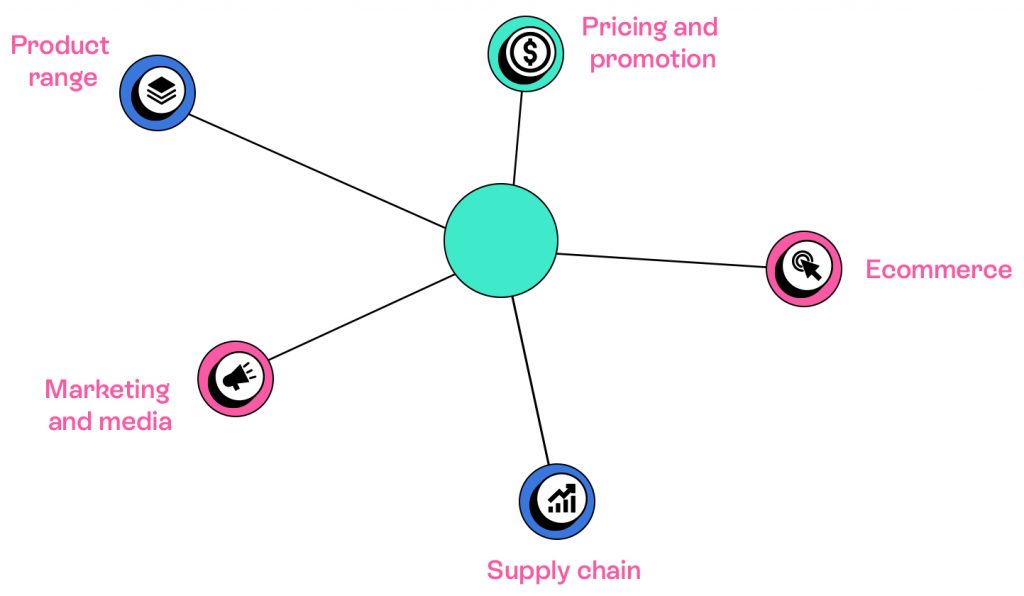Category:
Podcast
Series:
#2
Episode:
#4
Date:
February 2023
Stream on Spotify
The future of retail?
Imagine a world of intelligent retail decisions, powered by customer data, insight, and machine learning. Sounds great, doesn’t it?
You can live in that world with decision intelligence.
Gartner predicts more than a third of large businesses will use decision intelligence in the next two years. But how does it apply to retail? And how can retailers get started?
Let’s go back to the beginning. It all started with a research paper…
Let’s rewind to 2008.
Decision intelligence is a fast-growing tech category. Dr. Lorien Pratt and Mark Zangari first introduced the field in their research in 2008. Then in 2018, Cassie Kozyrkov developed it further in her role as Chief Decision Scientist at Google.
Fast forward to 2023 and Alibaba has named decision intelligence one of their “top ten technology trends”.
A unique point of view.
At HyperFinity, we define decision intelligence as the commercial application of data science and artificial intelligence (AI). It enables faster, joined-up, customer-centric decision making.
Although AI is a key component of decision intelligence, it’s not about replacing humans with fully automated processes. Instead, it’s about giving humans the tools and insight to make better decisions. It’s about putting customer data at the centre of decision making, linking together commercial decisions and layering data science and AI techniques – ultimately creating business value.
Data-led decision making isn’t a new concept.
Traditionally, retail decisions were made based on gut feel – driven by sales and profit, regardless of the impact on customers. However, times are changing, and retailers are becoming more engaged with putting customers at the centre of decision making.
Decision intelligence can help retailers on this journey. It supports faster, more accurate commercial decision making – all whilst understanding the impact of individual decisions on the rest of the business.
Insight is democratised so it’s in the hands of the right people, destroying data silos. This is particularly important when retailers are committing to a machine learning or AI project requiring significant financial investment and specialist resources. It’s essential that the resulting value is shared with other departments, so they can layer on those efforts – accelerating decision making across the business.
Ultimately, decision intelligence allows teams to forecast the holistic impact of decision making across interlinked business areas.
It’s not about total automation.
We’ll never replace high quality human decision making – but can we augment it?
Decision intelligence is a great example of technology augmenting decision making. Retailers’ decision-making functions don’t necessarily have the right data, tools or solutions at their fingertips – or the data science skills to derive insight from data.
Decision intelligence enables retailers to automate repetitive decisions and processes; giving internal data science teams more time for innovative research and development tasks. It goes above and beyond business intelligence (BI), by simulating outcomes to guide decision makers – for example, what happens if you increase prices? What’s the outcome of targeting a specific customer group?
Retail decisions are interlinked.
Decision intelligence can answer connected retail problems – we often talk about this as retail optimisation:
- Pricing: how can you intelligently price products to maximise margin?
- Range: how can you optimise your product assortment on the channels you sell through?
- Marketing and media: how can you connect customer data to put the right products in front of the right people?
- eCommerce: how can you use data science and AI to increase conversions and loyalty?
- Supply chain: how can you make sure products are available when customers want to buy them?
Decisions in these areas are interlinked. Let’s use pricing as an example. When changing the price of an isolated product, it’s straightforward to run regression or price elasticity analysis to predict the impact on demand. However, this doesn’t take substitutability or affinity into account – or predict how demand may transfer to other products within the same category. This demonstrates the connected nature of retail decisions: pricing decisions are interlinked with supply chain decisions, for example. And that’s what decision intelligence is all about – connecting data and decisions across every retail function.

Data is the lifeblood of retail.
Retailers are already collecting the insights needed to power decision intelligence:
- Transactional data, or sales data.
- Product data, such as the products you sell, the features you use to describe them, your product categories and how they fit in your taxonomy.
- Customer data, including demographics like age and location, and any segments.
- Click data, if you trade online. Every click or interaction can be captured to understand consumer behaviour.
To get started with decision intelligence, start by auditing the data you currently capture and the technology you’ve already adopted. Is your current technology stack working for decision makers?
Next, map out how your organisation currently makes key decisions. For example, when it comes to making frequent, costly decisions around pricing or marketing, how do you currently use data and resources? Do decision makers have access to the insights needed to perform their jobs? Think about where you’d like to improve and make faster, data-driven decisions with greater confidence. This kind of exercise is useful for building a framework for introducing AI into decision making.
Think of it as three layers:
The data enterprise layer.
A centralised data store or repository, that’s accessible, scalable and built on modern architecture.
The decision intelligence layer.
The AI, BI and data science solutions and tools providing decision makers with insights, helping them make better commercially focused decisions.
The activation layer.
An execution platform, such as a CMS, ERP or CRM system.
The decision intelligence age has already started.
Companies putting data at the heart of their business are more likely to succeed.
Decision makers need access to data and insight to drive profitable commercial outcomes and improved customer experiences – faster.
Retailers like Amazon and Tesco have been collecting data and putting it at the heart of commercial decision making for years. For example, Tesco Clubcard was introduced in 1995. As well as rewarding customers with loyalty points every time they shop, Tesco collects data such as total spend, products purchased and where you shopped. Within one year of launching, customers were spending 28% more. Today, 10 million households actively use Clubcard.
Many major UK grocery retailers, including Tesco, are creating new revenue streams by selling advertising to the brands they stock and monetising data. The retail media era is here.
Meanwhile, fashion retailers like Nordstom and Nike are innovating with marketing, personalisation and immersive customer experiences. ASOS is using AI to enhance shopping experiences – customers can use a visual search tool on their app to find styles they’ve saved on their mobile device.
For retailers looking to compete and succeed in a challenging market, decision intelligence is a really powerful tool. Contact us to start making connected retail decisions.



